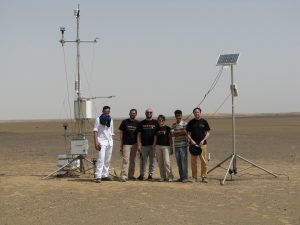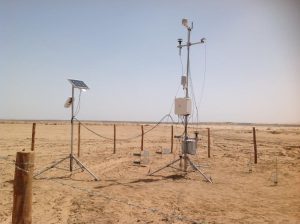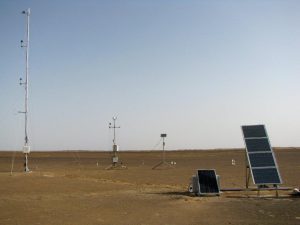30 June 2016
Electric forces in desert air create mighty dust storms, study finds
Posted by Lauren Lipuma
by Lauren Lipuma

Francesca Esposito and her research team carried out two experiments in the Sahara Desert in the summers of 2013 and 2014 to tease apart the relationship between electricity and lifting of dust into the air during dust storms.
Credit: Francesca Esposito.
Electric fields in dust storms have been discovered lifting 10 times more dust into the air than winds alone, according to new experiments conducted in the Sahara Desert. The discovery has big implications for global climate studies, as well as for understanding dust storms on Mars.
The phenomenon found in the Sahara is similar to that of thunderstorms, where colliding ice particles in clouds create an electric field in the sky – a separation of positive and negative charge that is neutralized by lightning. In desert air, collisions of dust and sand particles also generate electricity and can even produce lightning. But the new study shows something even stranger happens: when conditions are just right, the electricity helps to lift more dust into the air, initiating powerful dust storms, according to the study’s authors.
Airborne dust particles have a major impact on global climate, but whether they intensify warming due to climate change is a huge unknown, according to Nilton Renno, an atmospheric and planetary scientist at the University of Michigan in Ann Arbor who was not involved in the study. By showing how electric forces influence the dust lifting process, the new study helps scientists tease apart the relationship between dust and climate, according to Francesca Esposito, a planetary scientist at the National Institute for Astrophysics in Naples, Italy.
“In order to predict climate changes, it is important to understand how much dust is lifted from the surface and in which conditions,” said Esposito, lead author of the new study published in Geophysical Research Letters, a journal of the American Geophysical Union. These conditions are usually estimated using climate models, but until now, climate models haven’t included the effects of electricity in the air. “This effect is important because it lifts more dust than expected,” Esposito said.
Humidity and electricity
Airborne dust affects Earth’s climate in several ways. Dust from deserts and other dry regions absorbs and scatters light and heat from the sun and acts as condensation nuclei that help clouds form. In addition, wind carries dust from the Sahara across the Atlantic to the Amazon, where it fertilizes rainforest plants. Previous mathematical models of dust transport suggested electric forces could affect how dust is lifted into the air, but this effect has never been proven, Esposito said.

The research team used these instruments to measure wind speed, air pressure, temperature, humidity, the electric field strength, and more.
Credit: Francesca Esposito.
Esposito and her team performed two experiments in the Moroccan Sahara Desert in the summers of 2013 and 2014 to study how electricity influences dust lifting in the real world. These are the first experiments ever to record concentrations of dust in the air and the strength of the electric field at the same time, she said.
The researchers found the more dust was lifted into the air, the stronger the electric field became, and the stronger the electric field, the more dust was lifted. This feedback effect, as it is called, was very strong and very fast: on the order of seconds or less, Esposito said. The feedback effect was so strong that when wind speeds reached a certain threshold, the electricity lifted 10 times more dust into the air than normal, according to the study.
The team also found dust lifting and the strength of the electric field depend on the humidity of the ambient air. They saw that when the relative humidity reached a certain threshold – between 20 and 30 percent, depending on the dampness of the sand – the same amount of dust generated a weaker electric field compared to dry conditions. “The presence of water [in the air] changes the electrical properties of the salts,” Esposito explained. “The charge that is exchanged between particles is different when the humidity is high.”

The solar-powered instruments allowed the researchers to understand the role of the atmospheric electric field in the dust lifting process.
Credit: Francesca Esposito.
Esposito is not sure of the mechanism for this change, but the researchers suspect that above the humidity threshold, salts lifted from the sand absorb water and dissolve, creating a liquid film around sand and dust grains that changes their ability to transfer charge to one another.
Implications for Mars exploration
Understanding the relationship between dust, electricity and weather on Earth is also important because it will be studied in future missions to Mars. This October, the first mission of the European Space Agency’s ExoMars program will arrive on the red planet and deposit the Dust Characterization, Risk Assessment, and Environment Analyser on the Martian Surface (DREAMS) package. DREAMS will provide the first measurements of electric fields on the surface of Mars.
“In order to understand the data that will come from Mars, we need to have a clear understanding of the physics of the phenomenon on Earth,” Esposito said. “This will be a unique opportunity to understand if on Mars, as on Earth, dust dynamics has a feedback in the electrical properties of the atmosphere.”
—Lauren Lipuma is a public information specialist and writer at AGU. You can follow her on twitter at @lipumal.



 GeoSpace is a blog on Earth and space science, managed by AGU’s Public Information staff. The blog features posts by AGU writers and guest contributors on all sorts of relevant science topics, but with a focus on new research and geo and space sciences-related stories that are currently in the news.
GeoSpace is a blog on Earth and space science, managed by AGU’s Public Information staff. The blog features posts by AGU writers and guest contributors on all sorts of relevant science topics, but with a focus on new research and geo and space sciences-related stories that are currently in the news.